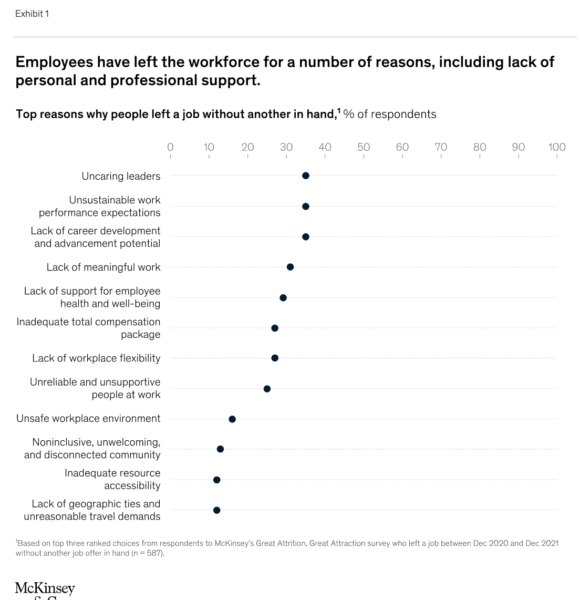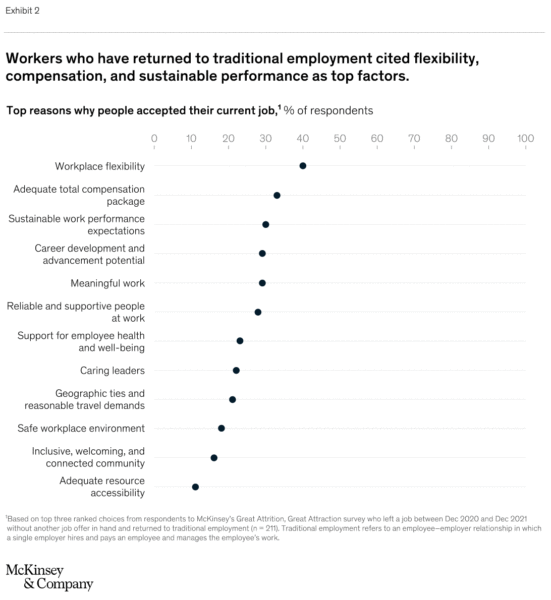Gone for now, or gone for good? How to play the new talent game and win back workers
March 11, 2022

Nearly half of the employees who voluntarily left the workforce during the pandemic aren’t coming back on their own. Employers must go and get them. Here’s how to start.
No, you aren’t imagining it: workers are leaving your company faster than you can replace them. According to the US Bureau of Labor Statistics, more than 4.3 million people voluntarily quit their jobs in December 2021, slightly below a record high in November 2021.
Their departures have left a huge hole in the labor market. The number of current job openings (10.9 million) exceeds the number of new hires (6.3 million). And in our own recent survey of almost 600 workers who voluntarily left a job without another in hand, 44 percent said that they have little to no interest in returning to traditional jobs in the next six months. 1
In the past, spikes in voluntary attrition often signaled a competition for talent, where in-demand workers left one job for a similar but better one at another company. This most recent wave of attrition is different. Most are leaving to take on very different roles—or just leaving the workforce entirely. They have been operating under extreme circumstances for extended periods and have been unable to find an adequate balance between work and life—so they are choosing “life” until they absolutely need to go back.
The competition for talent is different now, too. Employers are competing with the full array of work experiences available to today’s employees—traditional and nontraditional jobs and, in some instances, not working at all. 2 To get in the game, companies must offer adequate compensation and benefits packages; that is the ante. But to win, they must recognize how the rules of the game have changed. While workers are demanding (and receiving) higher compensation, many of them also want more flexibility, community, and an inclusive culture (what we call relational factors) to accept a full-time job at a traditional employer.
Traditional employers must compete across all these elements. They will likely need to adopt entirely new tactics to find and attract “latent” talent—workers who aren’t currently looking to rejoin the labor market but who might come back if they get the right offer.
In this article, we look at the employees who left a job without another in hand, who returned and why, and how companies can begin to bring more workers back into the fold. Now more than ever, companies must redefine their attraction and retention strategies and build a value proposition that takes employees’ whole lives into account. The longer they wait, the more burnout they will create among existing employees, potentially leading to even more attrition.
Among those who quit, attrition was most apparent in the consumer and retail, healthcare, and education sectors—industries that have felt some of the greatest social and economic pressures during the pandemic.
Why are employees leaving?
Because they can. Leaving a job used to be anxiety inducing; it isn’t anymore. The cost of switching jobs has gone down significantly. There is much less of a stigma associated with showing a gap in your résumé. Because of the current labor shortage and the greater acceptance of remote work, employees in many industries are confident that they can find work anywhere, whenever they are ready. They have access to more information about the labor market than ever before—through word of mouth and social-media sites, for instance—so they don’t need to rely on the usual recruiting resources. They have seen friends and colleagues depart and survive, and they are confident that they can, too.
Because they are upset. Those who voluntarily left cited experiences with uncaring leaders, unsustainable expectations of work performance, and lack of career advancement as factors in their decision (Exhibit 1). Employees witnessed how companies furloughed or laid off their colleagues during business slowdowns. Those who remained resented being told to shoulder greater burdens and put in more time (sometimes with suboptimal resources) to help keep operations afloat.

Because they are exhausted. Our research shows that poor mental health (burnout and stress), family-care demands, and reflections on purpose because of the COVID-19 pandemic played big roles in why some workers left their companies without another job in hand. Consider the couple who, after two years of stressful, isolating remote work in their respective jobs, realized they could get by on one income as a trade-off for spending more time with their children. Among those who quit, attrition was most apparent in the consumer and retail, healthcare, and education sectors—industries that have felt some of the greatest social and economic pressures during the pandemic.
Of the almost 600 employees we polled who voluntarily left a job without another in hand, 47 percent returned to the workforce in either traditional or nontraditional work arrangements.
Why are some employees returning?
Because they want to. It’s complicated, but for reasons relating to the state of personal health and finances, outreach from people in their networks, dissatisfaction with start-up experiences, and so on, some employees have started to return to traditional employment. Of the almost 600 employees we polled who voluntarily left a job without another in hand, 47 percent returned to the workforce in either traditional or nontraditional work arrangements. Almost a quarter of the returnees took up nontraditional work, while 76 percent went back to traditional employment. The latter group cited workplace flexibility, adequate compensation, and reasonable expectations about performance as top factors in their decision to return (Exhibit 2). Only 21 percent went back to work in the same sector and assumed roles at a similar level as those they left.

Workers who have returned to traditional employment cited flexibility, compensation, and sustainable performance as top factors.































